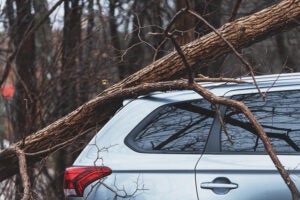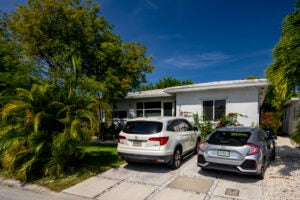What are the different types of car insurance coverage?




Key takeaways
- Most states require drivers to carry liability coverage, including bodily injury liability and property damage liability.
- Uninsured/underinsured motorist, personal injury protection and medical payments coverage are optional in some states and required in others.
- Collision and comprehensive coverage are optional, but if you finance or lease your vehicle, you may be required to carry them.
- Depending on the carrier, other optional coverage types may include roadside assistance, rental car reimbursement, new car replacement, gap insurance and accident forgiveness.
Car insurance can be broken down into many individual types of coverage, and not every driver needs to buy each type. The most basic auto insurance types are bodily injury and physical damage liability coverage, which transfers your financial responsibility for accidents you cause to your insurance company, and optional collision and comprehensive coverages, which pays for damage to your insured vehicle if you hit another vehicle or stationary object, as well as theft, vandalism and severe weather. Bankrate’s insurance editorial team broke down the various types of car insurance coverage to help drivers make informed decisions when buying a policy.
Common types of car insurance
The most common types of car insurance can be broken down into two broad categories: required coverage and optional coverage.
In nearly every state, required coverage begins with liability insurance, including bodily injury and property damage liability coverage. In addition to liability insurance, some states require drivers to carry first-party medical coverage, such as personal injury protection or medical payments (MedPay) coverage, and/or uninsured/underinsured motorist coverage.
Optional car insurance coverage focuses on the policyholder’s insured vehicle. Collision and comprehensive coverage are both optional, but may be required by lenders for financed or leased vehicles. About 80 percent of U.S. drivers carry collision and comprehensive, according to the Insurance Information Institute (III).
Required car insurance: liability coverage
The foundation of any car insurance policy is liability insurance, a type of coverage that transfers a portion of your legal and financial responsibility for damage or injuries caused in an accident to your insurance company. Liability coverage is broken into two types: bodily injury and property damage liability. There’s also a form of coverage that will pick up other drivers’ liability if they have insufficient liability coverage, known as uninsured and underinsured motorist coverage.
The liability coverage on your policy, which has no deductible, helps cover the cost of lawsuits, including your legal defense and any damages you are ordered to pay up to your policy limits.
Bodily injury liability (BI)
If you’re found at fault in a car accident that resulted in injuries to other parties, your bodily injury liability coverage can pay for the other party’s medical bills up to your policy’s limits. Bodily injury liability coverage is typically written in split limits, which means your policy covers a separate amount for injuries to a single person and in a single accident. For example, a $25,000/$50,000 bodily injury policy would cover up to $25,000 for a single individual’s medical bills and a total of $50,000 for medical bills across the entire accident.
-
You run a red light and hit another vehicle. The driver of the other vehicle suffers a whiplash injury and their passenger sustains a broken leg. Because you’re at fault, the driver and passenger can file bodily injury claims with your insurance company.
If your policy has split limits for bodily injury of $25,000 per person and $50,000 per accident, your insurance company will cover up to $50,000 to cover the combined medical bills of the driver and passenger — but only $25,000 per individual. If the passenger’s broken leg generates $26,000 in medical bills, the policy will only cover $25,000, even if the per-accident limit of $50,000 hasn’t been met.
Property damage liability (PD)
Property damage liability coverage pays to repair the damage you cause to others’ property — not your own — in an at-fault accident. Your insurance company will probably write this as a single limit. For instance, you might see $25,000 under your property damage coverage on your auto policy. This means you have $25,000 worth of coverage to repair something you hit, such as another car, a pole, a house or another stationary object.
-
You hit a patch of black ice and run into a light pole. The city assesses the damage to the pole and determines that it will cost $5,000 to repair it — and you’re responsible for that bill. If you carry $25,000 of property damage on your policy, you’d have more than enough coverage to pay for the repairs.
Uninsured and underinsured motorist bodily injury coverage (UM/UIM)
Uninsured motorist (UM) coverage and underinsured motorist (UIM) coverage are two different car insurance coverage types, but they are frequently listed together on your auto policy.
Uninsured motorist coverage pays for your medical bills if another driver hits you and they don’t have any bodily injury liability to cover your medical expenses. This coverage may also apply if you are the victim of a hit-and-run. Underinsured motorist coverage, on the other hand, pays for medical bills that exceed the at-fault driver’s bodily injury liability limits. These coverage options may or may not be mandatory, depending on your state.
This also may cover damage to your vehicle depending on how your policy is written and if you don’t have collision coverage.
-
You’re in a car accident, and the at-fault driver was uninsured. You incur $25,000 worth of medical bills and carry $25,000/$50,000 in uninsured motorist coverage. Having this coverage would allow you to file a claim with your own insurer instead of the at-fault party’s provider and help you avoid out-of-pocket medical expenses.
Uninsured motorist property damage (UMPD)
Uninsured motorist property damage pays to repair the damage to your vehicle if someone hits you and they don’t have insurance. In some states, uninsured property damage is mandatory. In others, it’s not offered or is optional. UMPD can have a maximum payout limit and a mandated or limited deductible option. Also, many states require the driver of the uninsured vehicle to be identified for the coverage to apply, meaning it is often not an option for hit-and-run accidents.
In states where UMPD is not offered, UM will cover damage to your vehicle.
-
Someone hits your car in a parking lot and causes $700 in damage to your vehicle. The driver doesn’t have insurance. However, you have uninsured motorist property damage on your policy, so your insurance company could make a payout for your vehicle’s repairs minus your $100 deductible.
Someone rear-ends you, and as a result, you experience whiplash. Your medical bill is $3,000, and you carry medical payments coverage on your auto policy with a $5,000 limit. In this case, your medical payments coverage may pay your medical bill in full.
Personal injury protection (PIP)
Personal injury protection (PIP) is first-party insurance that pays for medical bills for you, your family or your passengers regardless of who was at fault in an accident. It can also cover lost wages and necessary expenses, such as child care or household services. Although this coverage isn’t available everywhere, PIP coverage is mandatory if you live in a no-fault state.
-
A driver runs through a stop sign and hits you as you proceed through the intersection. Your passenger was hurt and requires $4,000 worth of chiropractic treatment, which your personal injury protection could pay for.
Optional car insurance: physical damage coverage
Collision and comprehensive insurance, key components of a full coverage car insurance policy, are the two primary types of physical damage coverage. No state law requires drivers to carry these types of coverage, but lenders typically make them a contract requirement if you’re leasing or financing a vehicle.
Unlike most required coverage, comprehensive and collision insurance come with deductibles. A car insurance deductible is the amount you agree to pay out of pocket in the event of a covered claim, essentially sharing a small part of the financial risk that your insurance policy covers the bulk of. Deductibles help insurers to avoid small claims and save money over time, thus reducing the overall cost of auto insurance.
Collision (COLL)
Collision coverage pays for the damage to your vehicle regardless of who is at fault in an accident. It also covers rollover accidents and pothole damage.
Unlike the liability coverage options, collision doesn’t have a written limit. Instead, it will cover up to your vehicle’s value after depreciation, also called the actual cash value or ACV.
-
You forget to check your blind spot and sideswipe a vehicle while changing lanes. The total damage to your car is estimated to be $1,200. You carry collision coverage on your vehicle with a $500 deductible. Since the deductible is your responsibility, your insurance company would pay $700 toward the repairs.
Comprehensive (COMP or OTC)
Comprehensive coverage, sometimes known as “other than collision (OTC)” coverage, pays for the damage to your car resulting from acts of nature (such as hail, wind and floods), fire, theft, vandalism, falling objects and hitting an animal. Comprehensive also covers cracked windshields. Like collision, comprehensive carries a deductible. However, in some states, policyholders have the option to have a separate glass deductible for windshield replacement. Glass deductibles may be lower than the comprehensive deductible and could be as low as $0.
-
A deer darts in front of you, and you hit it head-on. Your car has major front-end damage as a result, and the repair bill totals $7,000. You carry comprehensive insurance with a $500 deductible, so your insurance company would pay $6,500 toward the repairs and you would be responsible for the $500 deductible.
Other types of car insurance coverage
Most car insurance companies will offer the auto insurance types outlined above with standard policies — but your coverage options don’t stop with comprehensive and collision. Depending on your location and your carrier, you may also be able to add additional medical coverage, protection for newly purchased vehicles and various forms of roadside assistance.
Medical payments coverage (MPC or MedPay)
Medical payments coverage, which is not offered in all states, is typically available as an optional coverage that pays toward medical bills for you and your passengers, no matter who is at fault in the accident. Unlike PIP, which is required in no-fault states, MedPay is only required by law in Maine and New Hampshire — and unlike PIP, MedPay won’t cover lost wages or replacement services. This coverage is written on a per-person basis, and the coverage limit usually ranges from $1,000 to $10,000. Additionally, medical payments coverage may apply if a vehicle hits you as a pedestrian.
-
Someone rear-ends you, and as a result, you experience whiplash. Your medical bill is $3,000, and you carry medical payments coverage on your auto policy with a $5,000 limit. In this case, your medical payments coverage may pay your medical bill in full, but it won’t cover income you may lose out on while you’re recovering.
Gap insurance
Gap insurance is an optional coverage that you may be able to purchase when financing or leasing a new vehicle. As a vehicle ages, it tends to depreciate in value. This depreciation can sometimes cause you to owe more money on your car than it’s worth. In this instance, gap insurance could step in to pay the difference if your new vehicle is totaled in a covered loss or stolen and unrecoverable. This coverage type is typically only available for vehicles less than three years old.
-
The actual cash value of your financed vehicle is $15,000, but you owe $20,000 on your loan. You’re the driver in an at-fault accident, and the damages are severe enough that your insurance company declares your vehicle a total loss. After your $500 collision deductible, your claims check is $14,500. Your gap insurance could then cover the $5,500 balance between the actual cash value of your vehicle and the remaining balance on your loan so you’re not stuck paying off a totaled vehicle.
New car replacement coverage
New car replacement coverage is optional, and it pays for a brand new car if your vehicle is totaled and no more than a couple years old or under a certain mileage.
-
You bought a brand new car six months ago, but you were just involved in an accident, and the vehicle was totaled. If you carry new car replacement coverage on your policy, your insurance company would pay for a brand new car rather than a six-month-old car (which would have been comparable to the vehicle that was totaled in the covered loss).
Roadside assistance coverage
Every company’s version of roadside assistance coverage is different, but it typically covers towing, flat tires, battery jump starts and locksmith services. Adding roadside assistance to your car insurance policy may be more affordable than paying for a separate roadside assistance membership.
-
Your car breaks down while taking a road trip. You have roadside assistance coverage, so you call your car insurance company, and they send you a tow truck at no out-of-pocket expense.
Rental car coverage
Rental car coverage, sometimes called rental reimbursement, will cover all or part of the cost of a rental car if you need one while your vehicle is repaired due to a covered loss. It’s available up to a set number of days and/or dollar amount.
-
You run off the road and your vehicle needs significant repairs, which are taken care of by your collision coverage. Your vehicle needs to be in the shop for two weeks, but because you carry rental car coverage, your insurance company would pay for your rental up to a certain amount each day.
How to find the best car insurance coverage
Every driver has different insurance needs. Determining the balance between your coverage needs, your insurance budget and other priorities such as customer experience and discount availability is key to finding the best coverage for you.
The bare minimum your policy must include is the liability and other coverage required by your state’s laws. A minimum coverage policy is the cheapest option, but it may not offer enough financial protection for most drivers. With rising car repair costs and an uptick in dangerous driving, you could be responsible for tens of thousands of dollars of financial responsibility following a single accident — and most state’s minimum liability limits only cover up to $50,000 or even less.
Most insurance professionals recommend raising your liability limits above state requirements and adding comprehensive and collision coverage to your policy, unless you own a car that isn’t worth much or can afford to replace your vehicle without insurance. Beyond these basic coverage choices, though, your needs and budget may vary.
If you’re not sure how much car insurance you need, you may want to speak with an insurance professional. Once you’ve found your ideal coverage level, compare rates from multiple companies for those coverage limits to find the best price for your profile.
Frequently asked questions
-
No single insurance company offers the best auto coverage for every driver. While most insurers offer the same basic coverage types — liability, collision, comprehensive, uninsured/underinsured motorist, personal injury protection and medical payments — rates may vary based on underwriting practices and the risk factors in your driver profile.
-
Talking to a licensed insurance agent can help you take stock of your financial situation as it relates to your insurance needs. In general, it’s advisable to carry enough liability coverage to cover your assets and expected future earnings. In addition, if you have a loan or lease on your vehicle, or if you’re not comfortable paying out of pocket to replace your vehicle in the event of a total loss, you may need comprehensive and collision coverage. Working with an agent can help you determine the exact levels of coverage that work for you.
-
You can cancel car insurance at any time — but doing so without another policy lined up could put you in violation of state laws unless you’ve already canceled your vehicle registration with the DMV. Insurance companies may also impose higher rates in the future if they see a coverage lapse in your history. If you need to cancel coverage on a car you’re still driving, you’ll want to have another policy ready to go into effect the same day.
-
Some insurance companies offer accident forgiveness for purchase, but it’s not an option with all carriers or in all states. Other companies, such as State Farm, only offer accident forgiveness as a perk to be earned by longtime policyholders who meet certain requirements over time, such as staying accident-free for a specified number of years.
You may also like

How do deductibles impact your car insurance?

What is a comprehensive car insurance claim?

How much car insurance do I need?

